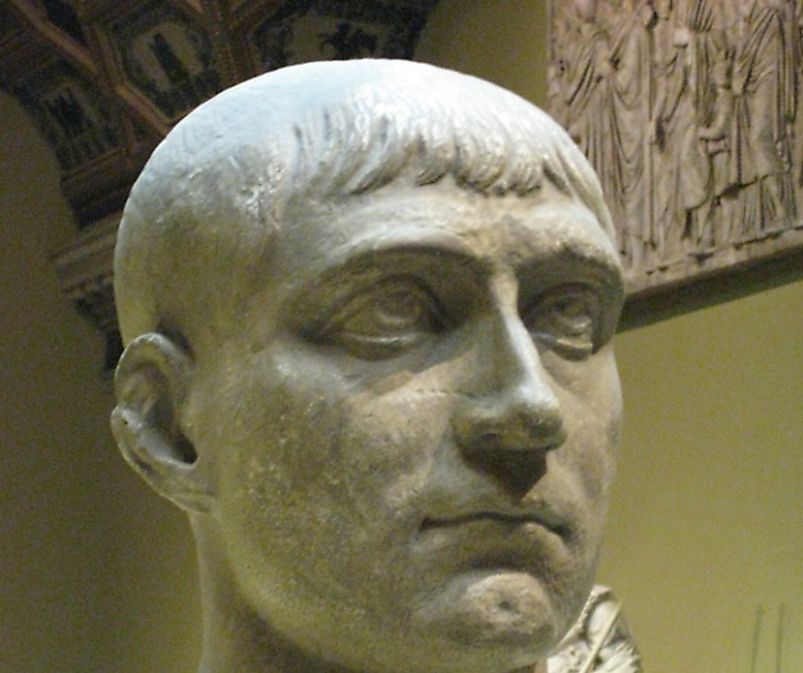The Western Roman Empire: 285 AD to 476 AD

5. Formation
The Roman Empire expanded beyond its initial city-state of Rome because of the many successful battles and campaigns the Romans fought against their neighbors and other groups of people as far away as the Celts in Britain. Conquests promoted further conquests, and the Roman territory grew, but this pattern could not continue indefinitely. The new battles were not profitable to wage, and the Empire became too large to govern from the central seat of Rome. Therefore, in 276 AD, the Emperor Diocletian divided the empire into two halves, the Eastern Empire being governed out of Byzantium (later Constantinople and now Istanbul), while the Western Empire continued to be ruled from Rome.
4. Rise To Prominence
While the Emperor Diocletian continued to rule in the Eastern half, he designated Maximian to serve as the Emperor of the Western part. They were each called Augustus. Secondary to them were the two Caesars. Galerius was the Caesar in the East, and Constantius was the Caesar in the West. Sometimes the Caesars were also referred to as Emperors. This arrangement was called a Tetrarchy, meaning a system of governance by four rulers. The West’s Constantius died in 306 AD, and his son Constantine became Augustus (the Emperor) of the West. Many other claimants also attempted to rule the Western half as well. However, in 308 AD, through a conference, the West was divided between Constantine and a newcomer, Licinius. Constantine and Licinius had stabilized their respective parts by 314 AD, with Constantine being Rome’s first Christian emperor. After Constantine’s death in 337 AD, a civil war broke out among his three sons. This resulted in division of the Western Empire into three parts.
3. Challenges
Between 316 AD and 476 AD, the Western Empire faced at least six major civil wars. The West periodically pursued hostile policies against the East, including several incursions into the Eastern territories by the West’s General Stilicho in the late 4th Century and early 5th Century AD. These conflicts significantly weakened the Western half’s economy and, as the economic strain grew, the Empire’s resources and capabilities to deal with corruption, agricultural production, currency stability, trade leverage with the East, and maintaining expensive armies also plummeted. The West was challenged by pressures on its borders as well. Various Germanic tribes, who were looking for new places to settle, were constantly causing tension along the empire’s borders. The Western Roman army found it difficult to control these incursions. Eventually, in September of 476 AD, the (last) Roman emperor of the West, Romulus Augustulus, was dethroned by a Germanic leader named Odovacar.
2. Demise
Even after the disintegration of the Western Roman Empire, the Eastern part continued to thrive as the Byzantine Empire for many more years. Therefore, the "fall of Rome" often refers only to the fall of the Western part of the Empire. Some historians implicate Christianity as being a major factor in the fall of the Western Empire. Christianity preached the existence of single God, while the traditional Roman religion alternately professed many Gods, and of the Emperor as a God. Therefore, as Christianity spread, it significantly weakened the authority and credibility of the emperor in the minds of the general population, and made many traditional Roman believers feel displaced by the new faith.
1. Legacy In History
The Eastern Roman Empire spoke Greek, while the Western Roman Empire spoke Latin, and was Roman Catholic. The Latin language gave rise to many modern languages, including French, Italian, Portuguese, Romanian, and Spanish. It also influenced Germanic languages such as Dutch, English, and German. The Roman Catholic Church remains one of the most significant legacies of the Western Roman Empire. Major portions of Europe largely became Roman Catholic under the Western Empire's rule, and regarded the Pope as the Vicar of Christ. Today, the Roman Catholic church is still a major global force in society and politics.











